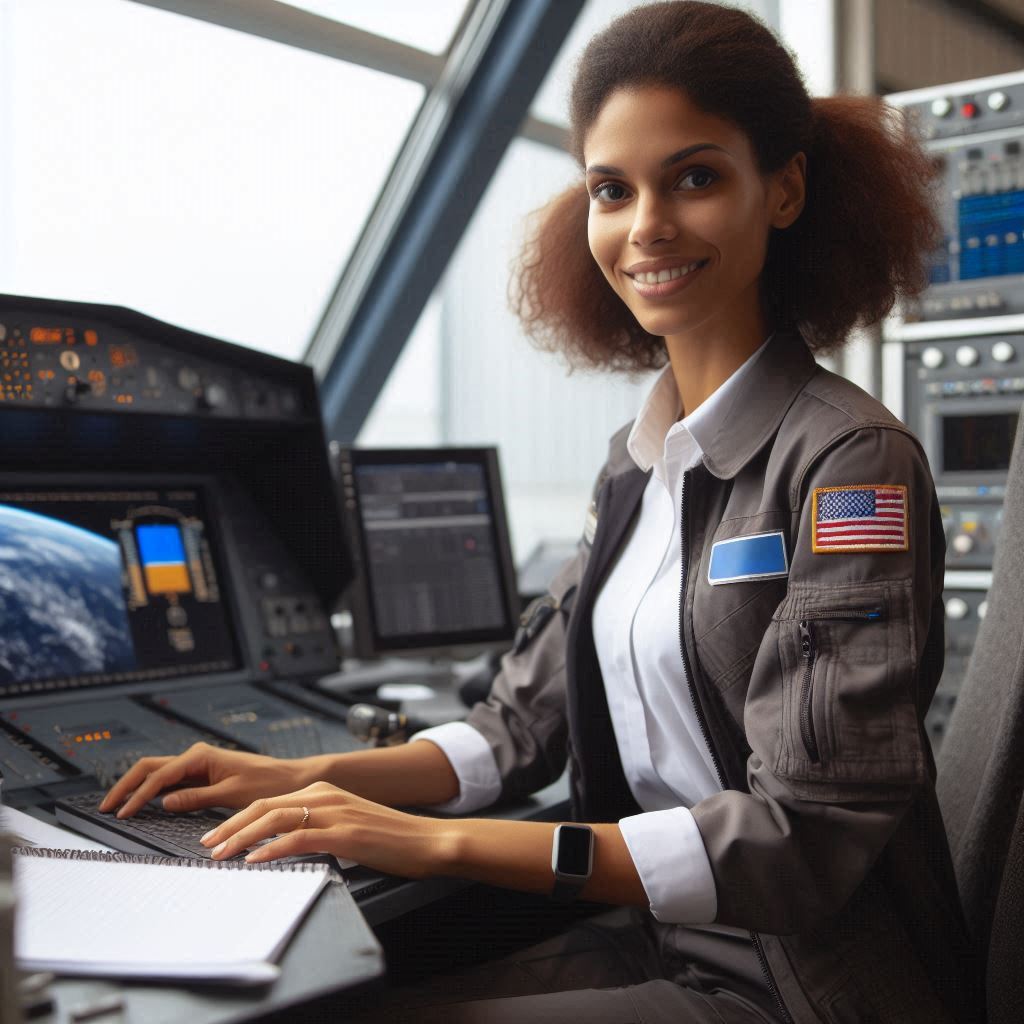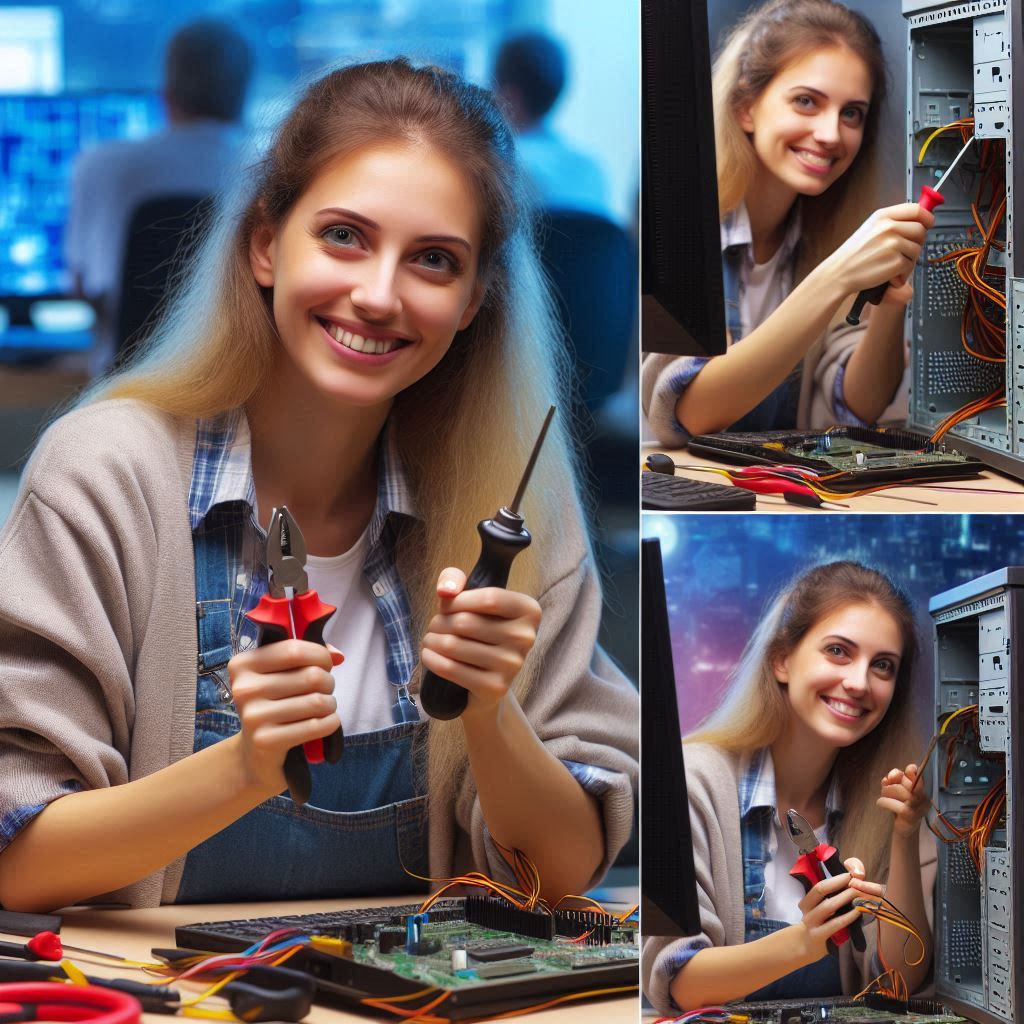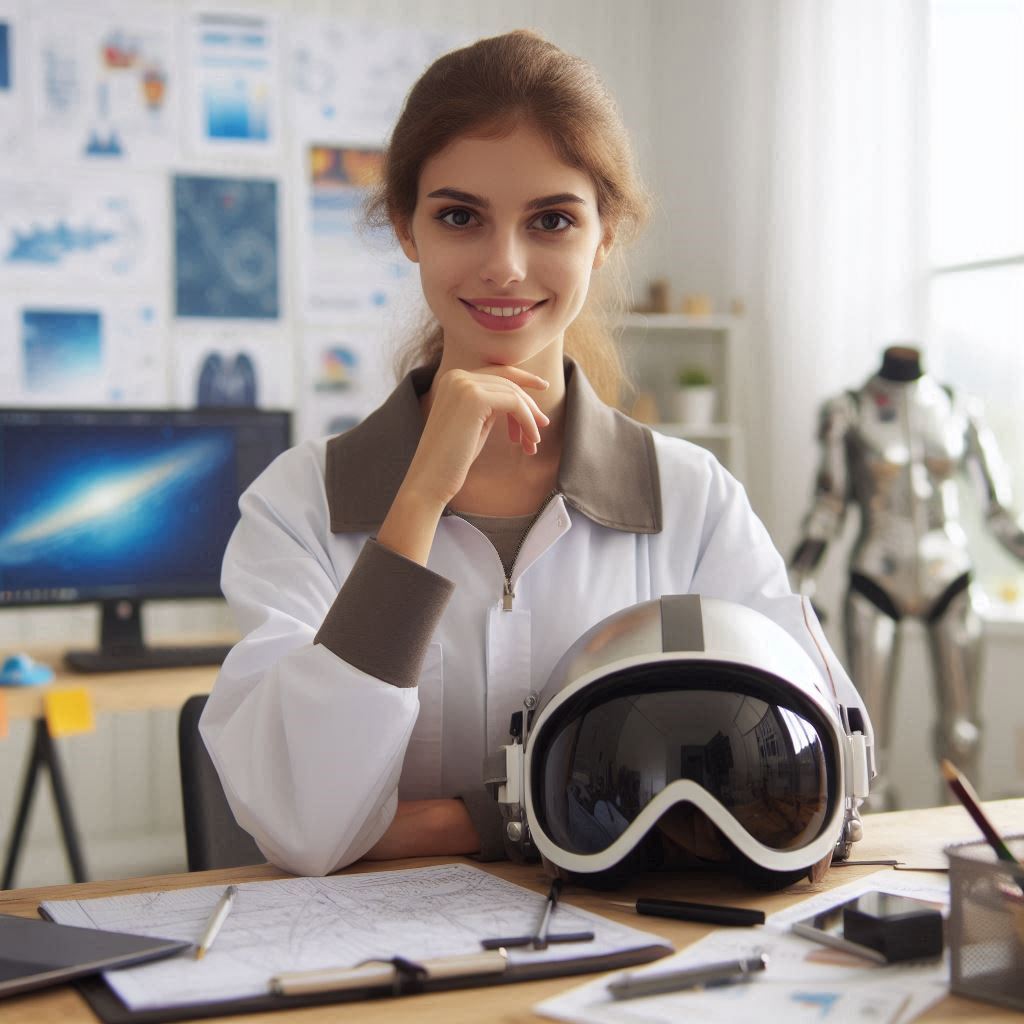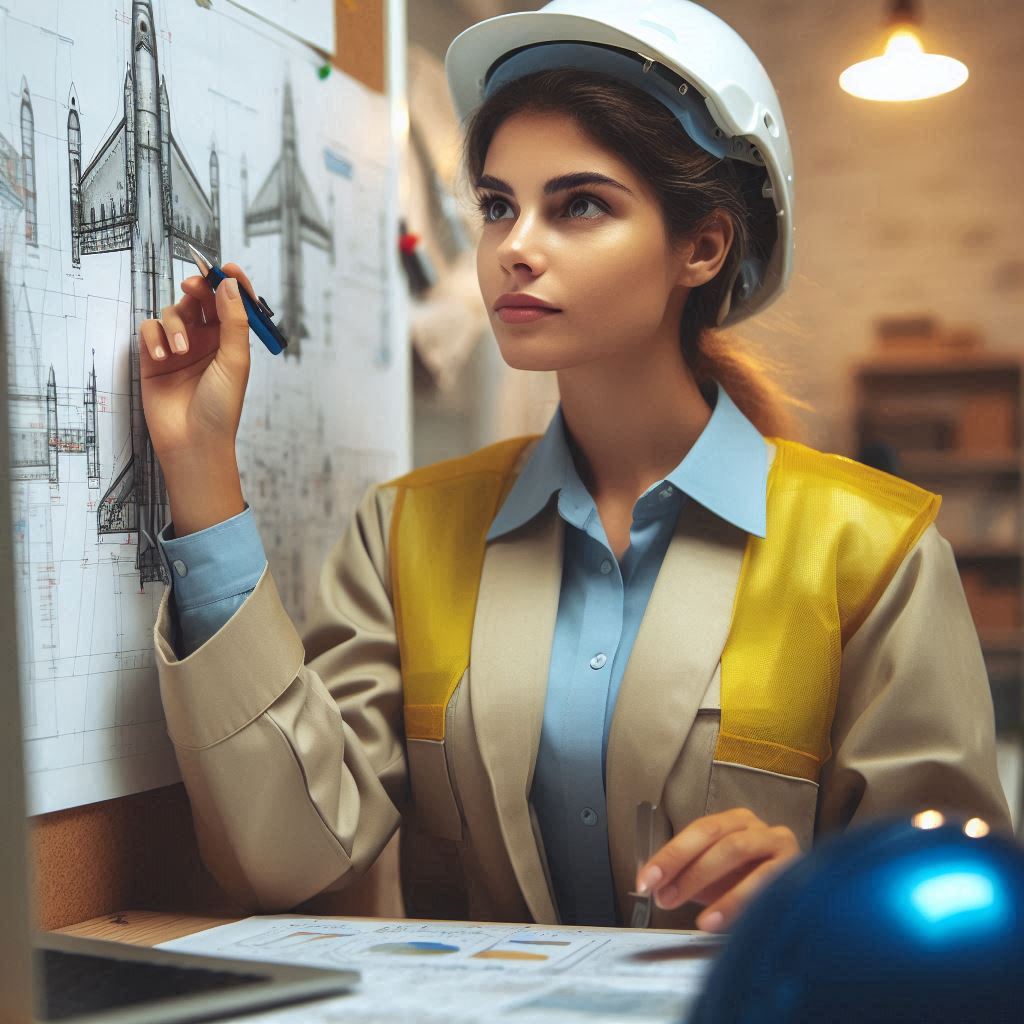Introduction
Women in aerospace engineering play a crucial role in shaping the future of aviation and space exploration.
Their contributions span across design, research, and innovation, driving advancements in technology and improving safety standards.
Historically, women faced significant barriers in this field, but their perseverance and talent have led to groundbreaking achievements.
The significance of women’s contributions to aerospace engineering is immense.
Female engineers have been at the forefront of major technological milestones, from pioneering space missions to developing cutting-edge aircraft systems.
Their work has not only pushed the boundaries of what is possible but has also inspired future generations of engineers.
In this blog post, we will delve into the vital role that women play in aerospace engineering.
We will highlight notable female engineers who have made significant impacts on the industry.
Their stories exemplify how women’s expertise and innovation drive progress in this complex field.
We will also explore the challenges women face in aerospace engineering, including systemic barriers and gender biases.
Addressing these challenges is crucial for fostering a more inclusive and diverse industry.
Our discussion will include various initiatives aimed at supporting women in aerospace, such as mentorship programs, scholarships, and professional organizations.
History of Women in Aerospace Engineering
Women’s involvement in aerospace engineering has a rich and transformative history.
Their contributions have shaped the field significantly.
From early pioneers to contemporary leaders, women have made substantial strides in aerospace engineering, overcoming numerous challenges along the way.
History of women’s involvement in aerospace engineering
In the early 20th century, women began making their mark in aerospace engineering.
Amelia Earhart, though known primarily as a pilot, advocated for women’s roles in aviation.
She inspired many with her achievements and courage.
Another pioneer, Hedy Lamarr, co-invented a frequency-hopping spread spectrum technology, laying groundwork for modern communication systems used in aerospace today.
Key Achievements and Milestones
During World War II, women took on critical engineering roles.
The “Rosie the Riveter” campaign highlighted women working in aircraft manufacturing.
Women like Elinor Ostrom and Jacqueline Cochran broke barriers, with Cochran setting multiple aviation records.
In the 1960s, women’s contributions became even more prominent.
Katherine Johnson, Dorothy Vaughan, and Mary Jackson were instrumental in NASA’s success during the space race.
Their calculations and work were crucial for the success of the first American in space and the Apollo moon landings.
The film “Hidden Figures” brought their story to a wider audience, showcasing their vital roles.
In the 1980s and 1990s, women continued to break new ground.
Sally Ride became the first American woman in space in 1983, inspiring future generations of female engineers and astronauts.
Dr. Peggy Whitson became the first female commander of the International Space Station in 2007, highlighting the increasing leadership roles women have achieved in space missions.
Challenges and Barriers
Despite these achievements, women in aerospace engineering have faced significant challenges.
Historically, gender biases and stereotypes limited opportunities for women.
Many early female engineers had to contend with workplace discrimination and a lack of recognition for their contributions.
They often faced barriers to entry, including limited access to education and professional networks.
Institutional biases and cultural norms frequently undermined women’s efforts.
They had to navigate male-dominated environments where their capabilities were often questioned.
In many cases, women had to prove themselves repeatedly to gain acceptance and advancement in their careers.
In addition to systemic challenges, women also faced the struggle of balancing professional responsibilities with societal expectations of family roles.
Many female engineers had to overcome personal and professional obstacles to achieve their goals.
The history of women in aerospace engineering is marked by remarkable achievements and significant barriers.
From early pioneers to modern leaders, women have made vital contributions to the field.
Their success stories highlight both the progress made and the ongoing need to address challenges.
As we celebrate their achievements, it’s crucial to continue supporting and empowering women in aerospace engineering, ensuring that their contributions are fully recognized and valued.
Current Trends and Statistics
Current Statistics on the Representation of Women in Aerospace Engineering
The representation of women in aerospace engineering has been steadily improving, though challenges remain.
As of recent reports, women constitute approximately 14% of the aerospace engineering workforce.
This percentage reflects a gradual increase in female participation over the past decade.
However, it still falls short compared to other engineering fields where women’s representation is higher.
Efforts are ongoing to boost these numbers and create more inclusive environments.
Women hold key positions within aerospace companies, but the industry continues to seek greater gender balance.
The presence of women in leadership roles and technical positions is growing, but it remains uneven across different sectors.
Addressing these disparities is essential for achieving broader industry goals and fostering innovation.
Initiatives and Programs Aimed at Increasing Diversity in the Field
Several initiatives and programs aim to increase diversity in aerospace engineering.
Organizations like the Society of Women Engineers (SWE) work to support and promote women in STEM fields.
SWE offers mentorship, scholarships, and networking opportunities specifically for women engineers.
These resources help women advance in their careers and connect with peers and mentors.
Companies and educational institutions also implement diversity and inclusion programs.
Many aerospace firms have established partnerships with schools and universities to encourage young women to pursue aerospace engineering.
These programs often include internships, workshops, and outreach activities designed to inspire and prepare future engineers.
Government and industry-sponsored initiatives further support diversity.
Programs like NASA’s Women of NASA initiative highlight female role models and provide educational resources.
Such efforts aim to increase visibility and attract more women into aerospace careers.
Successful Women in Aerospace Engineering Who Are Making an Impact
Several successful women in aerospace engineering are making significant impacts in the field.
Dr. Peggy Whitson, a former NASA astronaut, has achieved remarkable milestones.
She holds the American record for the longest cumulative time spent in space by an astronaut.
Her achievements serve as an inspiration for many aspiring female engineers.
Another influential figure is Gwynne Shotwell, President and COO of SpaceX.
Shotwell’s leadership has been crucial in advancing space exploration and commercial spaceflight.
Her role in overseeing SpaceX’s missions and operations underscores the impact of women in top engineering roles.
Dr. Ellen Ochoa, the first Hispanic woman to go to space, is another prominent example.
Her work as a NASA astronaut and later as the director of the Johnson Space Center has made a lasting impact.
Ochoa’s career highlights the importance of diversity and representation in aerospace engineering.
In review, the representation of women in aerospace engineering is growing but still faces challenges.
Initiatives and programs are actively working to increase diversity and support women in the field.
Successful women like Dr. Peggy Whitson, Gwynne Shotwell, and Dr. Ellen Ochoa are making significant contributions, paving the way for future generations.
Their achievements underscore the importance of continuing efforts to foster inclusivity and innovation in aerospace engineering.
ion, while women are still underrepresented in aerospace engineering, efforts are being made to increase diversity and celebrate the achievements of women who are breaking barriers in the field.
Challenges Faced by Women in Aerospace Engineering
Women in aerospace engineering face numerous challenges, including bias and gender stereotypes that can hinder their career advancement in this male-dominated industry.
It is important to identify these challenges and find strategies to overcome them to encourage more women to pursue careers in aerospace engineering.
Transform Your Career Today
Unlock a personalized career strategy that drives real results. Get tailored advice and a roadmap designed just for you.
Start NowCommon Challenges and Biases
- Lack of representation: Women are often underrepresented in the aerospace engineering field, leading to feelings of isolation and a lack of support.
- Gender bias: Women may face unconscious bias, discrimination, and microaggressions in male-dominated work environments.
- Stereotypes: Gender stereotypes about women’s capabilities in technical fields can contribute to a lack of confidence and opportunities for advancement.
- Work-life balance: Balancing demanding work schedules in aerospace engineering with family responsibilities can be challenging for women.
- Promotion opportunities: Women may be overlooked for promotions and leadership roles due to biases and preconceived notions about their abilities.
Impact of Gender Stereotypes
Gender stereotypes have a significant impact on women’s career advancement in aerospace engineering.
These stereotypes often lead to a lack of recognition for women’s achievements, lower confidence levels, and limited opportunities for professional growth.
Women may face challenges in being taken seriously or given the same level of respect as their male counterparts.
Overcoming Challenges
Despite the barriers they face, women in aerospace engineering can employ various strategies to overcome challenges and advance their careers
- Networking: Building strong professional networks can help women connect with mentors, sponsors, and peers who can support their career development.
- Mentorship programs: Engaging in mentorship programs can provide guidance, advice, and opportunities for skill development and career advancement.
- Professional development: Investing in ongoing education and training can enhance women’s technical skills and qualifications, boosting their confidence and competitiveness in the industry.
- Advocacy and support: Women can advocate for themselves and seek out supportive allies within their organizations to help them navigate challenges and promote their accomplishments.
- Creating a supportive work environment: Encouraging diversity and inclusion initiatives in the workplace can help address biases and create a more supportive and inclusive environment for women in aerospace engineering.
By acknowledging the challenges and biases faced by women in aerospace engineering and implementing strategies to overcome them, we can work towards a more diverse and inclusive industry that values and supports the contributions of women in this field.
Read: How US Architects Adapt to Climate Change Concerns
Educational Opportunities for Women
Scholarships, Grants, and Programs
There are numerous scholarships, grants, and programs that are specifically designed to support women in aerospace engineering.
These opportunities aim to encourage more women to pursue careers in this field by providing financial assistance for their education.
For example, the Amelia Earhart Fellowship is a prestigious award offered by Zonta International that provides financial support to women pursuing doctoral degrees in aerospace-related sciences or engineering.
Additionally, the Society of Women Engineers (SWE) offers various scholarships and grants for female students studying engineering at all levels, including aerospace engineering.
Mentorship and Networking
Mentorship and networking are essential for women in aerospace engineering to thrive in their careers.
Having a mentor can provide guidance, support, and valuable insights into the industry.
By connecting with experienced professionals in the field through networking events, conferences, and online platforms, women can expand their knowledge, build relationships, and discover new opportunities.
Organizations like Women in Aerospace (WIA) and the American Institute of Aeronautics and Astronautics (AIAA) offer mentorship programs and networking opportunities specifically tailored to women in aerospace engineering.
Tips for Women Interested in Aerospace Engineering
- Develop a strong foundation in mathematics and science early on.
- Seek out internships or co-op opportunities to gain practical experience.
- Participate in extracurricular activities and clubs related to aerospace engineering.
- Attend conferences, workshops, and seminars to stay informed about industry trends.
- Build a professional network by connecting with other women in aerospace engineering.
- Stay curious, ask questions, and never stop learning.
By taking advantage of educational opportunities, mentorship, and networking, women can overcome barriers and succeed in the field of aerospace engineering.
Read: Diversity in the US Architectural Scene: A Deep Dive
Women in Leadership Positions
Women who have reached leadership positions
Firstly, Women have made significant strides in aerospace engineering, reaching prominent leadership positions.
Ellen Ochoa, the first Hispanic woman in space, later became the Director of the Johnson Space Center.
Tiera Fletcher, an aerospace engineer with Boeing, is known for her work on the Space Launch System.
Gwynne Shotwell, President and COO of SpaceX, has been instrumental in advancing commercial space travel.
Janet Kavandi, a former NASA astronaut and Director of the NASA John H.
Glenn Research Center, has made notable contributions to aerospace.
These women exemplify leadership and innovation in a traditionally male-dominated field.
Their achievements highlight the growing influence of women in shaping the future of aerospace engineering.
Impact of Women in Leadership Roles
Having women in leadership roles profoundly impacts the aerospace industry.
Women bring diverse perspectives and approaches to problem-solving and decision-making.
Their leadership fosters a more inclusive work environment and encourages collaboration.
Research shows that diverse teams often produce more innovative solutions and strategies.
Women leaders challenge the status quo and introduce new ideas that can drive industry advancement.
Their presence in leadership roles helps address gender biases and promotes equality within the industry.
By breaking barriers, women leaders pave the way for future generations of female engineers.
Their achievements inspire and motivate others to pursue careers in aerospace engineering.
Benefits of Diversity in Decision-Making and Problem-Solving
Diversity in decision-making and problem-solving offers numerous benefits.
Diverse teams bring a variety of viewpoints, leading to more comprehensive analyses and solutions.
Different experiences and backgrounds contribute to a broader range of ideas and perspectives.
This variety enhances creativity and innovation, crucial for tackling complex aerospace challenges.
Diverse teams are better equipped to understand and address the needs of a global customer base.
They can identify potential issues and opportunities that might be overlooked by more homogeneous groups.
Embracing diversity fosters a collaborative environment where all voices are heard and valued.
This inclusive approach drives better outcomes and more effective problem-solving.
Women in aerospace engineering have reached influential leadership positions, significantly impacting the industry.
Their presence enhances decision-making and problem-solving by introducing diverse perspectives.
The benefits of diversity in the workplace are clear, it fosters innovation, improves problem-solving, and drives progress.
As more women take on leadership roles, they continue to shape the future of aerospace engineering, creating a more inclusive and dynamic field.
Promoting diversity and supporting women in leadership roles will lead to a more innovative and successful aerospace industry.
Read: Freelance vs. Firm: Career Paths for US Architects
Future Outlook for Women in Aerospace Engineering
In order to understand the future outlook for women in aerospace engineering, it is essential to analyze the current trends and opportunities in the field and discuss the importance of promoting diversity and inclusion.
Additionally, providing recommendations for companies and organizations to support women in the industry will be crucial for shaping a more inclusive and equitable future.
Future Trends and Opportunities for Women in Aerospace Engineering
- Increasing participation: As more women enter the field, we can expect a rise in the number of female aerospace engineers.
- Leadership roles: Women are likely to take on more leadership positions, driving innovation and change in the industry.
- Specialized areas: With advancements in technology, women may excel in specialized areas such as space exploration and drone technology.
- Mentorship programs: Future trends may include mentorship programs to support and empower women in aerospace engineering.
- Global collaboration: Women from different countries may collaborate on international projects, fostering diversity and cooperation.
Importance of Promoting Diversity and Inclusion in Aerospace Engineering
- Innovation: Diversity brings fresh perspectives and ideas to the table, driving innovation in the aerospace industry.
- Talent pool: By promoting diversity, companies can tap into a larger talent pool and attract top female engineers.
- Representation: Having more women in aerospace engineering ensures better representation and a more inclusive work environment.
- Cultural sensitivity: In a global industry, diversity and inclusion promote cultural sensitivity and understanding among team members.
- Competitive edge: Companies that prioritize diversity gain a competitive edge by fostering creativity and collaboration.
Recommendations for Companies and Organizations to Support Women in the Industry
- Equal opportunities: Companies should offer equal opportunities for women to advance their careers in aerospace engineering.
- Mentorship programs: Establishing mentorship programs can provide guidance and support for women entering the field.
- Training and development: Investing in training and development programs for female engineers can enhance their skills and expertise.
- Fostering a supportive culture: Creating a supportive and inclusive work culture is essential for retaining and attracting women in aerospace engineering.
- Networking opportunities: Encouraging networking and collaboration can help women connect with peers and mentors in the industry.
In essence, the future outlook for women in aerospace engineering is promising, with opportunities for growth, leadership, and specialization.
Promoting diversity and inclusion is essential for driving innovation and creating a more inclusive industry.
By implementing recommendations to support women in the field, companies and organizations can help pave the way for a more equitable and diverse future in aerospace engineering.
Read: Iconic US Buildings and the Architects Behind Them.
Transform Your Career Today
Unlock a personalized career strategy that drives real results. Get tailored advice and a roadmap designed just for you.
Start Now
International Perspectives on Women in Aerospace Engineering
When it comes to the representation of women in aerospace engineering, different countries have varying levels of gender diversity within the field.
Here, we will compare the status of women in aerospace engineering in different countries, discuss cultural factors that may influence gender diversity, and highlight successful global initiatives for promoting gender equality in aerospace engineering.
Representation of Women in Aerospace Engineering
- United States: In the US, women make up only about 13% of aerospace engineering professionals.
- United Kingdom: The UK has a slightly higher representation of women in aerospace engineering, with around 20%.
- India: In India, the percentage of women in aerospace engineering is even lower, at approximately 10%.
- Germany: Germany also has a relatively low representation of women in aerospace engineering, at around 12%.
Overall, it is evident that women are significantly underrepresented in the field of aerospace engineering across various countries.
This lack of gender diversity can be attributed to several cultural factors that may influence women’s participation in STEM fields.
Cultural Factors Influencing Gender Diversity
- Social Norms: In many cultures, there is a pervasive belief that engineering and technology fields are better suited for men.
- Education System: Some countries may have educational systems that inadvertently discourage girls from pursuing STEM subjects.
- Workplace Environment: Aerospace engineering workplaces may have a male-dominated culture that can be unwelcoming to women.
- Family Expectations: Cultural expectations regarding family roles and responsibilities may deter women from pursuing careers in aerospace engineering.
These cultural factors play a significant role in limiting the representation of women in aerospace engineering.
However, there are several successful global initiatives that aim to promote gender equality in the field by addressing these challenges.
Successful Global Initiatives for Promoting Gender Equality
- Scholarship Programs: Many countries offer scholarships specifically targeted towards women pursuing degrees in aerospace engineering.
- Mentorship Programs: Mentorship programs provide women with support and guidance from experienced professionals in the field.
- Networking Events: Organizing networking events can help women connect with peers and establish a sense of community in aerospace engineering.
- Diversity Training: Implementing diversity training in workplaces can create a more inclusive environment for women in aerospace engineering.
By implementing these initiatives and addressing cultural factors that may hinder gender diversity, countries around the world can work towards creating a more inclusive and equitable environment for women in the field of aerospace engineering.
Conclusion
Women have made substantial contributions to aerospace engineering, significantly impacting the field with their expertise and innovative ideas.
Key points discussed include the trailblazing achievements of female engineers, the challenges they face, and the importance of fostering an inclusive environment.
Women like Mae Jemison and Sally Ride have broken barriers, serving as powerful role models and demonstrating the immense value of diversity in aerospace engineering.
Supporting and empowering women in aerospace engineering is crucial for the industry’s advancement.
Mentorship programs, educational initiatives, and workplace policies that promote gender equality are essential.
Encouraging women to pursue careers in aerospace and providing them with the necessary resources and opportunities ensures that the industry benefits from a wide range of perspectives and skills.
Diverse teams are proven to be more innovative and effective, driving progress and excellence in aerospace technology.
It is important for readers to advocate for gender diversity within the aerospace sector.
This involves actively supporting initiatives that promote female participation and leadership in engineering roles.
By challenging stereotypes, addressing systemic barriers, and fostering a culture of inclusivity, we can create an environment where women thrive.
Promoting gender diversity not only supports fairness and equality but also enhances the industry’s overall performance and creativity.
[E-Books for Sale]
The Big Book of 500 High-Paying Jobs in America: Unlock Your Earning Potential
$19.99 • 500 High-Paying Jobs • 330 pages
Explore 500 high-paying jobs in America and learn how to boost your career, earn more, and achieve success!
See All 500 High-Paying Jobs of this E-Book
1001 Professions Without a Degree: High-Paying American Jobs You Can Start Now
$19.99 • 1001 Professions Without a Degree • 174 pages
Discover 1001 high-paying jobs without a degree! Unlock career tips, skills, and success strategies for just $19.99!




